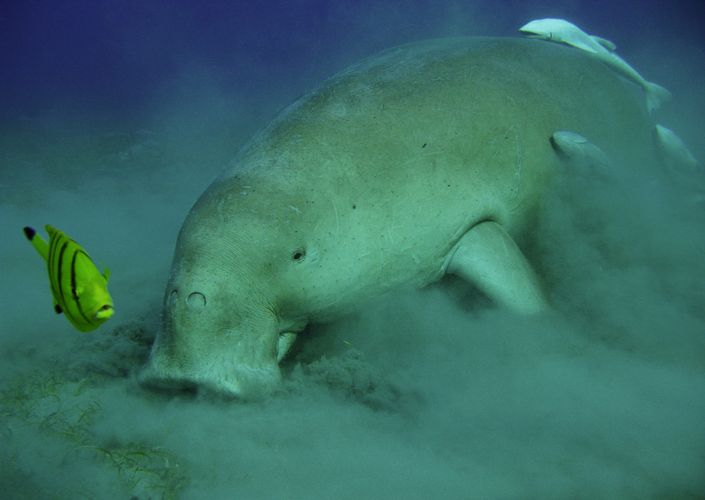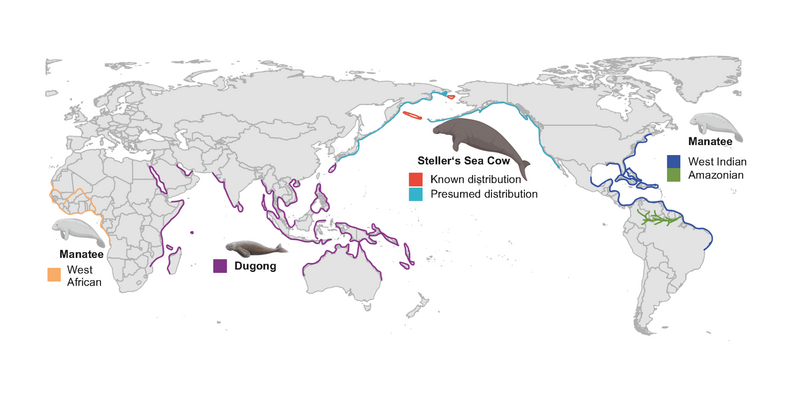The giant sea cow from the Ice Age was discovered in 1741 by Georg Wilhelm Steller and later named after him. The 18th-century naturalist was interested not only in the enormous size of this animal species but also in its unusual, bark-like skin. He described it as “a skin so thick that it is more like the bark of old oaks than the skin of an animal”. Such a bark-like structure of the epidermis is not found in related sirenians, which today live exclusively in tropical waters. In scientific circles, it was previously assumed that the bark-like epidermis was the result of parasite feeding, but also insulated heat and thus protected the sea cow well from the cold during the Ice Age and from injuries in the polar seas. In the current study, the scientists led by Dr Diana Le Duc and Professor Torsten Schöneberg from Leipzig University, Professor Michael Hofreiter from the University of Potsdam and Professor Beth Shapiro from the University of California, show that the palaeogenomes of Steller’s sea cow reveal functional changes. These changes were responsible for the bark-like skin and the adaptation to cold.
To find this out, an international research team from Germany and the US reconstructed the genome of this extinct species from fossil bone remains of a total of twelve different individuals. “The most spectacular result of our investigations is that we have clarified why this giant of the sea had bark-like skin,” said Diana Le Duc from the Institute of Human Genetics at Leipzig University Hospital. The scientists found inactivations of genes in the sea cow genome that are necessary for the normal structure of the outermost layer of the epidermis. These genes are also used in human skin. “Hereditary defects in these so-called lipoxygenase genes lead to what is known as ichthyosis in humans. This is characterised by a thickening and hardening of the top layer of skin with large scales, and is sometimes also known as ‘fish scale disease’,” said Schöneberg from the Rudolph Schönheimer Institute of Biochemistry. “The results of our research thus also sharpen our view of this clinical picture,” explained the biochemist, adding: “Here may lie the key to new therapeutic approaches.”
The scientists pinpointed the genetic defect by comparing the genome with that of the closest relative, the dugong. The researchers received support with their investigations from the Max Planck Institute for Evolutionary Anthropology in Leipzig, which contributed its bioinformatics expertise in the analysis of ancient DNA. As a result, they identified important evidence of genetic changes that may have contributed to adaptation to the cool North Pacific habitat. “This is an impressive example of how gene defects can not only cause disease, but also have advantages depending on the habitat,” said Hofreiter from the University of Potsdam. Furthermore, the genome data revealed a dramatic reduction in population size. This began 500,000 years before the species was discovered and may have contributed to its extinction. Hofreiter summed it up as follows: “With today’s molecular genetic clarification, our study closes the circle of an exact observation by a German naturalist in the early 18th century.”
The study result have been published in the journal Science Advances under the title:
“Genomic basis for skin phenotype and cold adaptation in the extinct Steller's sea cow”, doi.org/10.1126/sciadv.abl6496.
Background:
Georg Wilhelm Steller (1709–1746) studied medicine and the natural sciences in Leipzig, Jena and Halle and took part in the legendary expedition by Danish captain Vitus Bering to Alaska in 1741. Bering, after whom today’s Bering Strait was named, and many of the ship’s crew died during this expedition. Steller survived and was the first and only explorer ever to see and scientifically describe one of these gigantic sea cows alive. The related sea cows (sirenians) that exist today – manatees and dugongs – are found exclusively in tropical waters. They grow to a maximum length of three metres, less than half the body length of their ice-age ancestors. Of the former population of Steller’s sea cow of around 100,000 animals in the 18th century, only bones can be found today on the coasts of Bering Strait islands. Georg Steller first described the sea cow from the Ice Age in 1741. His landmark work was completed by his secretary on the basis of his manuscript and academic tributes. It was published in 1753, a few years after Steller’s death. He died on his return journey from eastern Siberia to St Petersburg.






























































